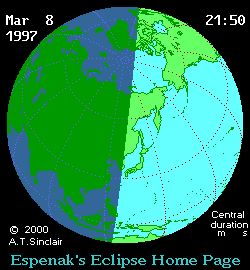Nature Total Magnitude 1.042 Max. width of band 356 km (221 mi) Start date March 9, 1997 | Gamma 0.9183 Duration 170 sec (2 m 50 s) Greatest eclipse 1:24:51 | |
 | ||
Total solar eclipse of march 9 1997 in russia full live video
A total solar eclipse occurred on March 9, 1997. A solar eclipse occurs when the Moon passes between Earth and the Sun, thereby totally or partly obscuring the image of the Sun for a viewer on Earth. A total solar eclipse occurs when the Moon's apparent diameter is larger than the Sun's, blocking all direct sunlight, turning day into darkness. Totality occurs in a narrow path across Earth's surface, with the partial solar eclipse visible over a surrounding region thousands of kilometres wide.
Contents
- Total solar eclipse of march 9 1997 in russia full live video
- Unusual gravity variations
- Solar eclipses 19972000
- Saros 120
- References
Unusual gravity variations
This solar eclipse is somewhat special in the sense that some unexplained gravity anomalies of about 7
Solar eclipses 1997–2000
Each member in a semester series of solar eclipses repeats approximately every 177 days and 4 hours (a semester) at alternating nodes of the Moon's orbit.
Saros 120
It is a part of Saros cycle 120, repeating every 18 years, 11 days, containing 71 events. The series started with partial solar eclipse on May 27, 933 AD, and reached an annular eclipse on August 11, 1059. It was a hybrid event for 3 dates: May 8, 1510, through May 29, 1546, and total eclipses from June 8, 1564, through March 30, 2033. The series ends at member 71 as a partial eclipse on July 7, 2195. The longest duration of totality was 2 minutes, 50 seconds on March 9, 1997.
